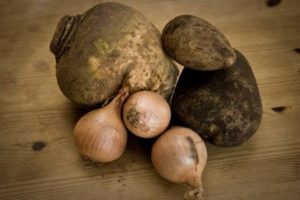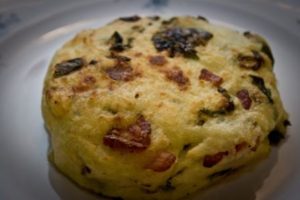Celeriac has a wonderful flavour, sweetness and crunch and it is at its best (in my opinion) when raw. Uncooked root vegetables must be dressed, it would be rude otherwise, and a classic celeriac remoulade is something I’ve always wanted to try. For me the remoulade needs to have creaminess, some acidity, freshness and a little mustard heat. Combine that with some lovely venison, peppery rocket and tangy sourdough and you’ve got yourself a match made in heaven.
Pork Wellington
I had to ask my butcher to save me a pork fillet as they sell out like there’s no tomorrow. Possibly because the pigs are fed mostly on apples for the latter part of their life meaning the meat has an unrivalled flavour. So with marvellous meat and flavourful fillings I set about making my pork wellington. If anyone knows why it’s called wellington I’d be pleased to find out; let’s hope it’s not an unflattering term for the shape of the finished meal.
You will need (for four):
500g pork fillet
1 pack puff pastry
250g mushrooms
Knob of butter
A small glass of white wine
1 egg, beaten
Salt and pepper
Wet Garlic, Bacon and Broccoli Pappardelle
Start by frying the onion in a little oil for a few minutes to soften. Add the bacon and fry for about five minutes until the bacon is cooked and the onions turning translucent. Add the garlic and reduce the heat. Fry for a few more minutes before pouring in the stock. Simmer this on a medium heat stirring occasionally. I used some of the chicken stock I had made from the leftover chicken.
While this cooks, add the pappardelle to boiling water. Four or five minutes before the pasta is ready, add the broccoli to the same water. The sauce should be reducing but turn the heat up or add a little more stock if it’s happening too fast or too slow. When the pasta and broccoli are done, add the broccoli and a little of the pasta water to the bacon sauce. Serve the broccoli, bacon, garlic mixture on top of the pappardelle.I was really surprised how the garlic mellowed with cooking. There was a definite garlic undertone to the dish but it was not as overpowering as I thought it might be. The salty bacon, sweet onion, pungent garlic and juicy broccoli were all married together beautifully with the chicken stock. If you’re lucky enough to get hold of wet garlic this is certainly worth a try (I also added it to frying Chorizo and it worked a treat), if you’re brave then you could try slicing it in to a salad.
Chicken and Chorizo Tartlets
First and foremost make the pastry. Rub the butter into the flour until you have breadcrumbs and then add drops of water until it comes together. Chill in the fridge for 30 minutes or so. Roll the pastry out and divide into four pieces. Line each tart tin with the pastry and prick the base with a fork. I thought I’d make a right mess of lining the tins but it was really quick and simple; no holes and no patching up required.
I tried that trick of pushing the rolling pin over the pastry when it’s in the case to remove the excess pastry from the edges and it worked brilliantly. Line the tarts with some baking paper and fill the tart cases with baking beans. Bake in a preheated oven at 200C for 15 minutes then remove the baking beans. I don’t think I was quite firm enough pushing my beans down as I did get a few air bubbles so I’ll be sure to be more forceful next time.The fiddliest part was the unfortunate but necessary step of removing the skins from the chorizo. They may be natural skins and fine to eat but I’d had them before and ended up having to pull the skins off after cooking and out of my teeth. I wasn’t prepared to spend the evening flossing so skin removal was essential. Once the skins are removed, chop the chorizo and fry on a medium heat so the oil runs out of the chorizo and it gets nice and crispy. Remove the chorizo from the pan leaving some of the oil and put the onion in. Fry the onion until soft and going brown at the edges; the smell was divine.
Coronation Chicken: using up leftover chicken
First and most importantly it was essential to make some form of chicken sandwich from the leftovers. As Jubilee fever is gripping the nation at the moment I thought the most appropriate sandwich would be Coronation chicken. Possibly my favourite sandwich filler but one I’ve never made myself and I wanted to do it properly, do it justice and so I set about making some mayonnaise.
You will need: 2 egg yolks 250ml oil (I used half groundnut, half rapeseed) Cooked chicken Curry Powder Mango Chutney Bread, salad, other sandwich bitsMy mixer would be the perfect thing to make glorious, fresh, silky mayonnaise, at least that’s what I thought. As far as I was aware 1 egg yolk can emulsify 100ml of oil but none of the recipes I found followed this rule so I trusted both my instincts (which are apparently useless) and a few recipes and went for 2 egg yolks and 250ml oil.
Lemon and Thyme Roast Chicken and the leftovers
Lemon and thyme roasted chicken is a classic, simple recipe. Shove it all together, chuck it in the oven and reap the rewards later.
You will need:
A chicken (I used a 1.4kg bird for two)
1 lemon
Fresh thyme
1 onion
Butter
Salt and pepper
Start by cutting the string off the legs and stuffing the cavity with a few sprigs of thyme and half a lemon. Cut the onion up into chunks and put them into a roasting tin with the other half of the lemon and a few more sprigs of thyme. Put the butter into a bowl and mix in some salt and pepper. Now comes the slightly tricky and disgustingly satisfying part; separate the breast meat from the skin. I use a spoon to do this to minimise ripping the skin. When skin and meat are sufficiently separated, stuff some of the butter under the skin. Rub the rest of the butter onto the outside, put in to the roasting tray and roast in the oven at 160C for an hour or so or until cooked through.
Sausage Rolls Four Ways
Originally I was just going to put a few caramelised onions in with the sausage meat but then I started thinking of other flavours; rosemary and fennel to start. With these new found thoughts I made a batch of eight sausage rolls, two of each of the following flavours; caramelised onion, herbs, fennel and olive. I think a nice spicy tomato chutney would have been brilliant too.
First of all make the caramelised onions. I used a whole onion, fried gently in butter for 20 minutes until soft and starting to brown then added sugar, salt and pepper. They were wonderfully sticky. While the onions are cooking; crush some fennel seeds, chop a few sprigs of fresh rosemary, parsley and chives and finely chop a few olives.
The Cornish Pasty
Before the pasty police come out in force and criticise my ingredients or method, I think it’s important to point out that I am not Cornish. However, my better half is half Cornish and his Grandmother a full on Kernow woman and she has passed on some of her pasty knowledge.
Making pasties is quite personal; only you know what proportions of vegetables and meat you like, how full you want your pasty to be and how big. Because of this I can provide a guide but you can change proportions at will. To make four large pasties I used: one large and one medium potato, half a swede, three small onions and 500g of skirt steak. For the pastry I used 400g of plain flour, 200g butter and enough cold water to make a dough.
Jerusalem Artichoke Gratin, Buttered Spring Greens and Sausages
The sausages I had for this were some lovely, local chipolatas from a fantastic butcher. My butcher not only knows everything there is to know about meat, he knows a fair few things about vegetables. I heeded his advice about cooking the spring greens and they turned out brilliantly – see below.
Jerusalem artichokes aren’t very big and to make the most of them I needed a helping hand from the potato. In total you need 450g finely sliced and peeled artichokes and potatoes. You don’t have to peel the artichokes if you give them a good scrub but I did. They have a tendency to go brown very quickly once peeled so speed is of the essence here.
Layer the finely sliced potatoes and artichokes in a baking dish, seasoning between each layer. Mix together 120ml cream and 180ml milk and pour this over. Place in an oven at 170C for an hour and twenty minutes.
Spring Green and Bacon Potato Cakes with Cheddar and Chive Sauce
|
For the potato cakes:
|
|
|
600g potatoes (Maris Piper are ideal)
|
£0.54
|
|
Milk and butter (for the mash)
|
£0.20
|
|
6 rashers smoked, streaky bacon
|
£1.50
|
|
4-5 big leaves savoy cabbage (or Spring greens)
|
£0.20
|
|
Salt and pepper
|
£0.02
|
|
For the cheese sauce:
|
|
|
25g butter
|
£0.15
|
|
25g plain flour
|
£0.02
|
|
300ml milk
|
£0.10
|
|
75g strong cheddar cheese
|
£0.85
|
|
Small handful fresh chopped chives
|
£0.40
|
|
Total
|
£3.98
|
First and foremost make some mashed potato. Maris Pipers I found to be particularly good; they are fluffy enough to make mash like a cloud and yet waxy enough to hold the greens and bacon in. Mash your potatoes as you see fit; add milk, butter, cream and anything you fancy but don’t forget the salt and pepper. While the potatoes are boiling away, slice some bacon and fry in a pan. Snap the leaves of the spring greens off and shred it finely. Add to the bacon and carry on frying until lovely and golden. For two people I used four rashers of bacon and five large spring green leaves.
- « Previous Page
- 1
- …
- 8
- 9
- 10
- 11
- 12
- 13
- Next Page »









